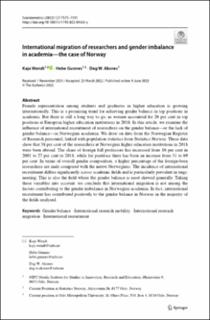| dc.contributor.author | Wendt, Kaja Kathrine | |
| dc.contributor.author | Gunnes, Hebe | |
| dc.contributor.author | Aksnes, Dag W. | |
| dc.date.accessioned | 2022-12-07T14:14:47Z | |
| dc.date.available | 2022-12-07T14:14:47Z | |
| dc.date.created | 2022-09-02T10:52:08Z | |
| dc.date.issued | 2022-06-08 | |
| dc.identifier.citation | Scientometrics. 2022, . | en_US |
| dc.identifier.issn | 0138-9130 | |
| dc.identifier.issn | 1588-2861 | |
| dc.identifier.uri | https://hdl.handle.net/11250/3036429 | |
| dc.description.abstract | Female representation among students and graduates in higher education is growing internationally. This is a promising trend for achieving gender balance in top positions in academia. But there is still a long way to go, as women accounted for 26 per cent in top positions at European higher education institutions in 2018. In this article, we examine the influence of international recruitment of researchers on the gender balance—or the lack of gender balance—in Norwegian academia. We draw on data from the Norwegian Register of Research personnel, linked with population statistics from Statistics Norway. These data show that 38 per cent of the researchers at Norwegian higher education institutions in 2018 were born abroad. The share of foreign full professors has increased from 16 per cent in 2001 to 27 per cent in 2018, while for postdocs there has been an increase from 31 to 69 per cent. In terms of overall gender composition, a higher percentage of the foreign-born researchers are male compared with the native Norwegians. The incidence of international recruitment differs significantly across academic fields and is particularly prevalent in engineering. This is also the field where the gender balance is most skewed generally. Taking these variables into account, we conclude that international migration is not among the factors contributing to the gender imbalance in Norwegian academia. In fact, international recruitment has contributed positively to the gender balance in Norway in the majority of the fields analysed. | en_US |
| dc.description.sponsorship | The research has been made possible through funding from the Research Council of Norway (Grant Number 295817). | en_US |
| dc.language.iso | eng | en_US |
| dc.publisher | Springer | en_US |
| dc.relation.ispartofseries | Scientometrics;Volume 127, issue 12 | |
| dc.rights | Navngivelse 4.0 Internasjonal | * |
| dc.rights.uri | http://creativecommons.org/licenses/by/4.0/deed.no | * |
| dc.subject | Gender balance | en_US |
| dc.subject | International research mobility | en_US |
| dc.subject | International reserach migration | en_US |
| dc.subject | International recruitment | en_US |
| dc.title | International migration of researchers and gender imbalance in academia—the case of Norway | en_US |
| dc.type | Peer reviewed | en_US |
| dc.type | Journal article | en_US |
| dc.description.version | publishedVersion | en_US |
| dc.rights.holder | © The Author(s) 2022 | en_US |
| cristin.ispublished | true | |
| cristin.fulltext | original | |
| cristin.qualitycode | 1 | |
| dc.identifier.doi | https://doi.org/10.1007/s11192-022-04365-y | |
| dc.identifier.cristin | 2048213 | |
| dc.source.journal | Scientometrics | en_US |
| dc.source.volume | 127 | en_US |
| dc.source.issue | 12 | en_US |
| dc.source.pagenumber | 7575–7591 | en_US |
| dc.relation.project | Norges forskningsråd: 295817 | en_US |

